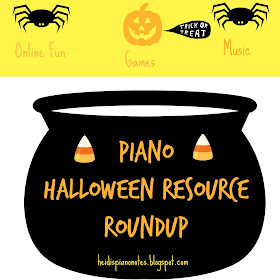I've found that sometimes the minor scale patterns can be a bit overwhelming for students to remember. I created this visual to help students see and hear the distinctions between the three types of minor scales.
I always think of a natural minor scale as a bit sad or melancholy and was surprised to hear one of students announce that he loves playing songs in minor keys.
The #'d 7th tone adds a creepy sounding appeal and of course makes the V7-i progressions sound so much more resolved, which is probably why the majority of minor pieces use the harmonic scale form.
I think of the melodic minor as kind of a "wanna be" major. As the scale ascends, it starts with that distinctive minor flatted 3rd, but then the #6th and #7th tones almost trick you into thinking its a major scale.... until it returns to the natural minor form as it descends.
Pages
▼
Monday, October 19, 2015
Friday, October 9, 2015
Ted-ED - Intriguing Videos on Music Topics
The Ted-ED questions led us to explore a variety of subjects including some of these other music related ideas.
Wednesday, October 7, 2015
Halloween Themed Free Piano Resources
It's a treat to pull the seasonal games and music and rediscover a few I've forgotten. I organized this list of free Halloween-themed music and activities posted by creative bloggers that I've enjoyed using in my studio for the past several years and added a few of my own as well.
My new tradition is to invite my students to do the "Don't Scare Me, Surprise Me! Challenge" every October for our monthly piano challenge. I introduce some of the activity options below at group lessons and then let them choose their favorites to complete from the challenge page.
Tuesday, October 6, 2015
Ponderizing with Music
To help my family better "ponderize"this scripture in 1 Timothy, I tried to pair the words to the tune of a familiar hymn. The theme of our church President, Thomas S. Monson's message this week was "Be an Example and a Light." Music definitely expedites memorization, and I love how scriptures that are put to song come back into my mind during mundane activities like driving, washing dishes or folding laundry to uplift my thoughts and spirit.
Finding a matching meter that emphasized the important words was challenging but I chose the opening verse of "Did You Think to Pray."
So instead of singing... We sing this...
Ere you left your room this morning Let no man despise thy youth, but
Did you think to pray? Be thou an example of the believers (quickly)
In the name of Christ our Saviour In word, in conversation
Did you sue for loving favour? In charity in spirit
As a shield today. In faith, in purity
As a shield today. 4:12 First Timothy
(lyrics by Mary A. Pepper Kidder)
I designed the pocket size image above so they can refer to their cards at school and "ponderize" throughout the day.,
Another fun piano resource that uses this similar method of adding lyrics to familiar tunes is "A Night at the Symphony" by Carol Matz. If you take a peek inside on amazon.com, you can read the clever lyrics paired with familiar classical pieces that introduce students to different elements of music history. Some of the selections are appealing melodies that I first learned while playing in middle school orchestra including Eine Kleine Nachtmusik, Surprise Symphony, Spring and the theme from 1812 Overture.
Finding a matching meter that emphasized the important words was challenging but I chose the opening verse of "Did You Think to Pray."
So instead of singing... We sing this...
Ere you left your room this morning Let no man despise thy youth, but
Did you think to pray? Be thou an example of the believers (quickly)
In the name of Christ our Saviour In word, in conversation
Did you sue for loving favour? In charity in spirit
As a shield today. In faith, in purity
As a shield today. 4:12 First Timothy
(lyrics by Mary A. Pepper Kidder)
I designed the pocket size image above so they can refer to their cards at school and "ponderize" throughout the day.,
Another fun piano resource that uses this similar method of adding lyrics to familiar tunes is "A Night at the Symphony" by Carol Matz. If you take a peek inside on amazon.com, you can read the clever lyrics paired with familiar classical pieces that introduce students to different elements of music history. Some of the selections are appealing melodies that I first learned while playing in middle school orchestra including Eine Kleine Nachtmusik, Surprise Symphony, Spring and the theme from 1812 Overture.
Thursday, October 1, 2015
Will Pay for Practice
This is one of the newest additions to my studio that I found at the local thrift store. Students earn quarters at their lessons by coming prepared to pass off 3 songs or keyboard skill levels . It has been a great motivation for all but the one "jellybean hater" in my studio. The biggest challenge is keeping the machine stocked!




